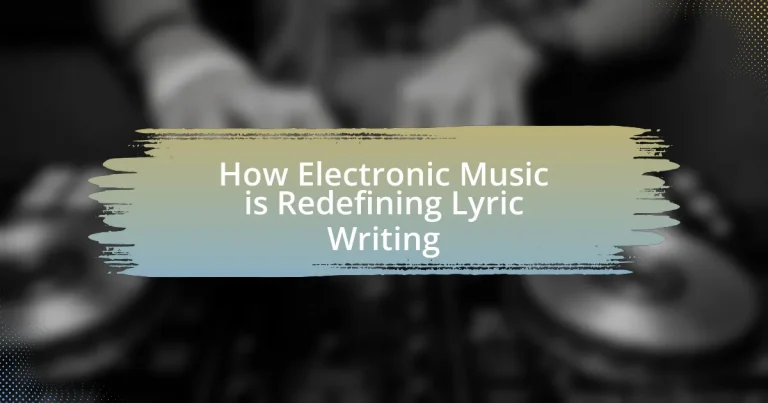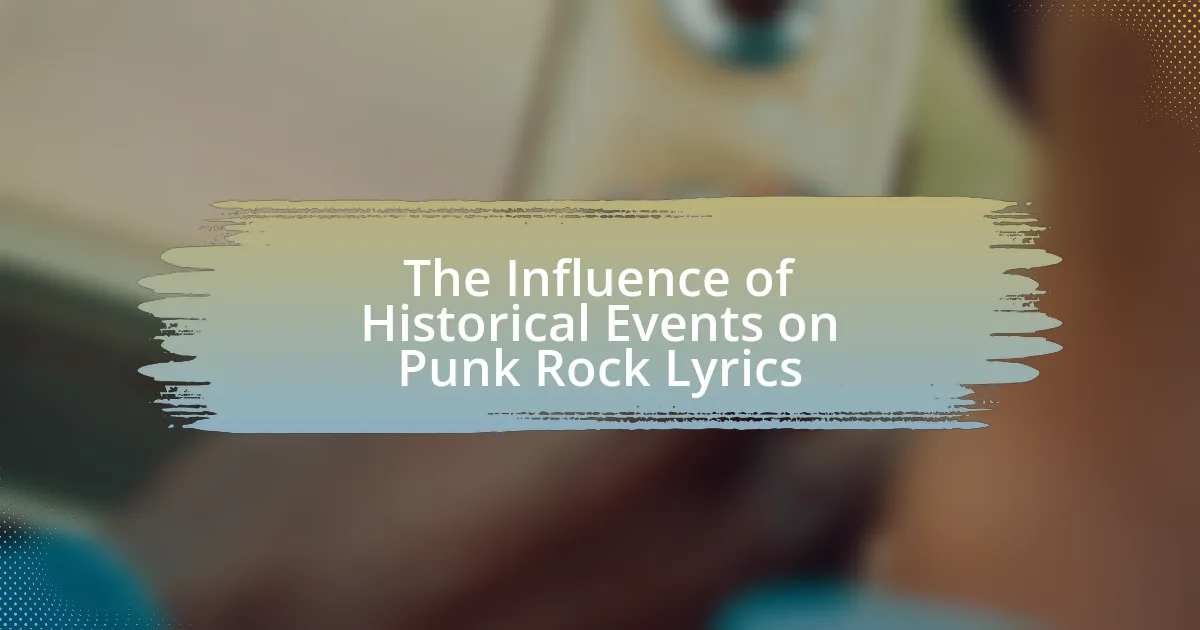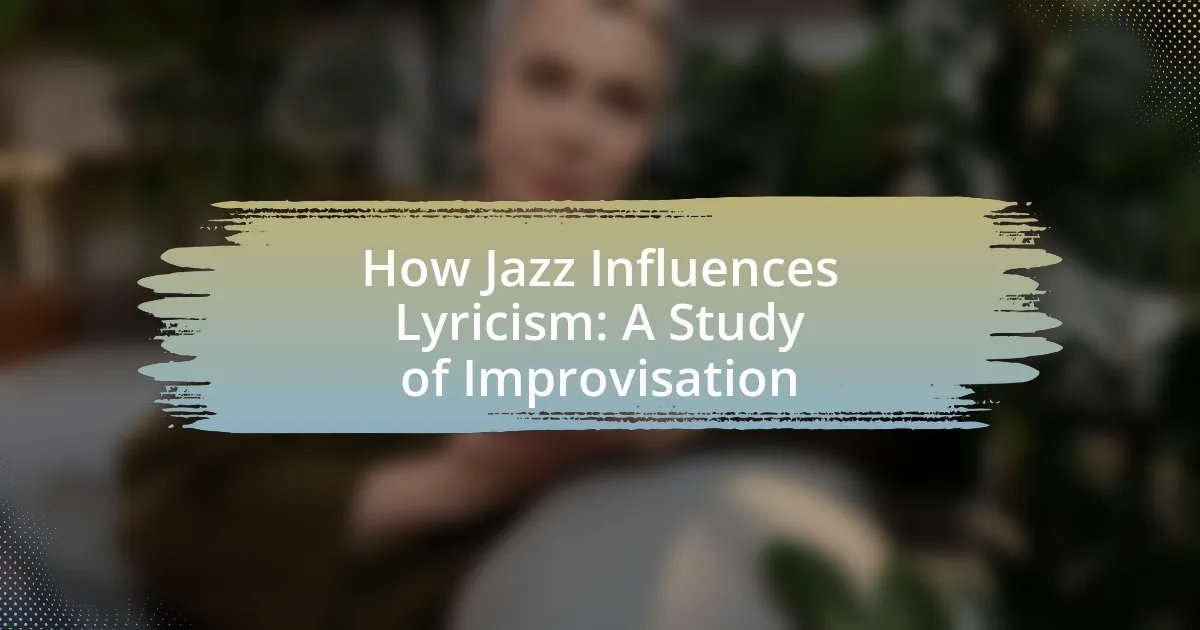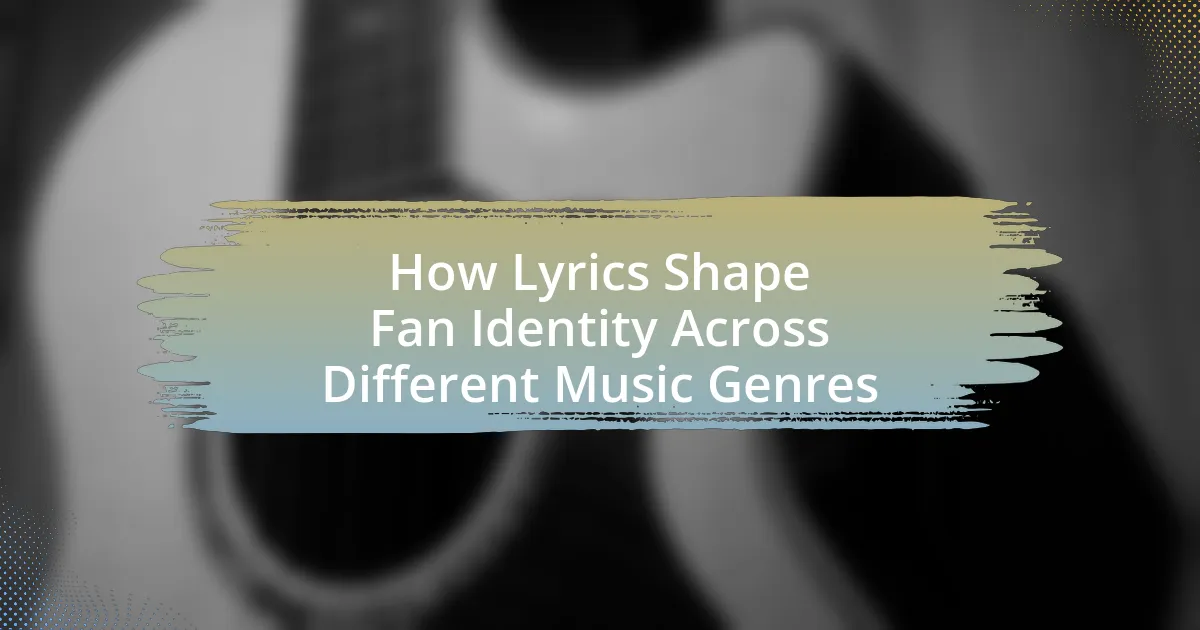Electronic music is significantly redefining lyric writing by prioritizing minimalism and repetitive structures, which enhance mood and atmosphere over complex narratives. Key characteristics influencing this shift include rhythmic structures, technological advancements, and a focus on emotional resonance. The article explores how production techniques shape lyrical themes, the role of technology in evolving lyrics, and the unique storytelling methods employed in electronic music. Additionally, it examines cultural influences, emerging trends, and the impact of collaborations and social media on lyrical content, while addressing challenges faced by lyricists in maintaining authenticity amidst commercial pressures.
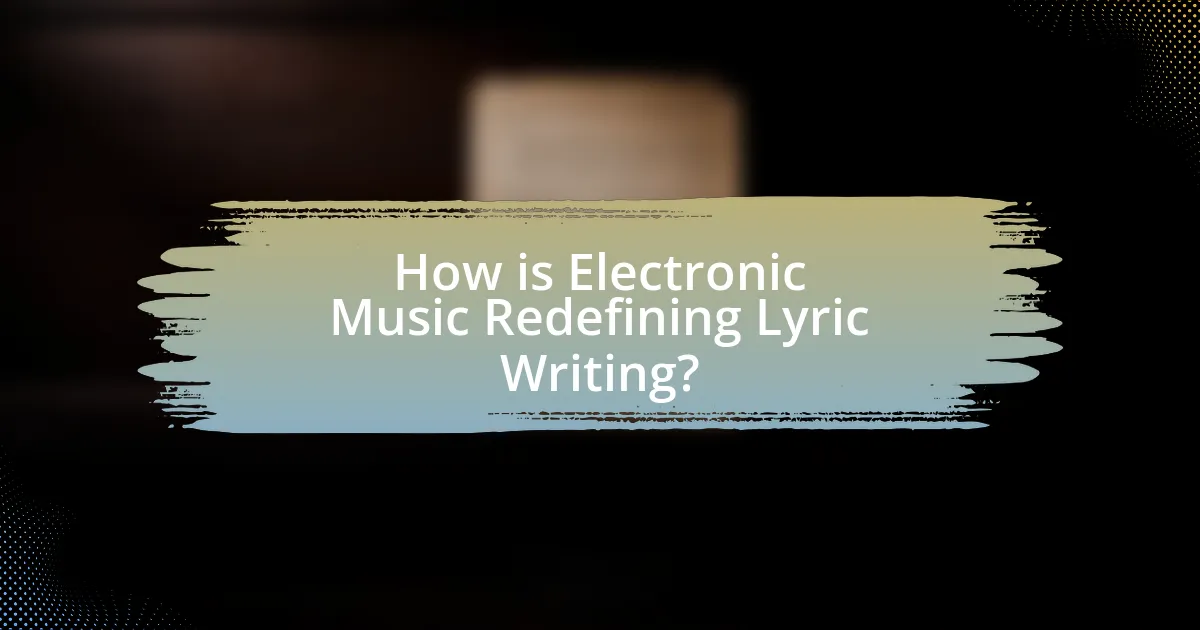
How is Electronic Music Redefining Lyric Writing?
Electronic music is redefining lyric writing by emphasizing minimalism and repetitive structures, which allows for a focus on mood and atmosphere rather than complex narratives. This shift is evident in genres like EDM and techno, where lyrics often serve as hooks or chants that enhance the sonic experience rather than convey detailed stories. For instance, artists like Calvin Harris and The Chainsmokers utilize simple, catchy phrases that resonate with listeners, aligning with the genre’s energetic and immersive nature. This approach reflects a broader trend in contemporary music where emotional impact and sonic texture take precedence over traditional lyrical depth.
What are the key characteristics of electronic music that influence lyric writing?
The key characteristics of electronic music that influence lyric writing include its rhythmic structure, use of technology, and emphasis on mood and atmosphere. The rhythmic structure often features repetitive beats and syncopation, which encourages lyrics that are catchy and concise, aligning with the danceable nature of the genre. The use of technology allows for innovative sound manipulation, leading to lyrics that may explore themes of futurism and digital culture. Additionally, the emphasis on mood and atmosphere in electronic music often results in lyrics that evoke emotions rather than tell a linear story, allowing for abstract and impressionistic expressions. These characteristics collectively shape how artists approach lyric writing within the electronic music genre.
How do production techniques in electronic music shape lyrical themes?
Production techniques in electronic music significantly shape lyrical themes by influencing the emotional tone and narrative structure of the lyrics. For instance, the use of synthesizers and digital effects can create an ethereal or futuristic soundscape, prompting lyrics that explore themes of technology, isolation, or transcendence. Additionally, techniques such as sampling and looping can emphasize repetitive lyrical motifs, reinforcing themes of obsession or cyclical experiences.
Research indicates that the integration of production elements, such as tempo and rhythm, directly affects lyrical pacing and delivery, which in turn shapes the listener’s emotional response. For example, faster tempos often lead to more urgent and intense lyrical content, while slower tempos may encourage introspective and contemplative themes. This relationship between production and lyrics is evident in genres like techno and house, where the interplay of sound and words creates a cohesive narrative experience.
What role does technology play in the evolution of lyrics in electronic music?
Technology significantly influences the evolution of lyrics in electronic music by enabling innovative songwriting techniques and enhancing lyrical expression. Digital audio workstations (DAWs) allow artists to manipulate sound and structure lyrics in ways that were previously impossible, facilitating the integration of spoken word, sampling, and vocal effects. For instance, the use of pitch correction software like Auto-Tune has transformed vocal delivery, allowing for more experimental and emotive lyrical interpretations. Additionally, advancements in music distribution technology have broadened access to diverse influences, encouraging artists to draw from various genres and cultures, which enriches lyrical content. This evolution is evident in the works of artists like Grimes and Skrillex, who utilize technology to push the boundaries of traditional lyricism, creating a new paradigm in electronic music.
Why is lyric writing in electronic music different from traditional genres?
Lyric writing in electronic music differs from traditional genres primarily due to its focus on repetitive and minimalistic structures that prioritize rhythm and atmosphere over narrative complexity. In electronic music, lyrics often serve as an additional layer to enhance the sonic experience rather than as the central storytelling element, which is common in genres like rock or folk. This approach allows for greater experimentation with sound and emotion, as seen in tracks by artists like Daft Punk and The Chemical Brothers, where the lyrics complement the beat and mood rather than drive the song’s message. Additionally, the use of technology in production enables unique vocal manipulations and effects that further distinguish electronic lyrics from those in traditional genres.
What unique storytelling methods are employed in electronic music lyrics?
Electronic music lyrics employ unique storytelling methods such as abstract imagery, non-linear narratives, and emotional resonance. These methods allow artists to convey complex themes and feelings without relying on traditional verse-chorus structures. For instance, abstract imagery creates vivid mental pictures that evoke emotions, while non-linear narratives enable a more fluid exploration of ideas, often reflecting the fragmented nature of modern experiences. Additionally, the use of repetition and minimalism in lyrics enhances emotional impact, allowing listeners to connect deeply with the music. This approach is evident in works by artists like Aphex Twin and Grimes, who utilize these techniques to craft immersive auditory experiences that challenge conventional storytelling in music.
How do cultural influences impact the lyrics of electronic music artists?
Cultural influences significantly shape the lyrics of electronic music artists by incorporating diverse themes, languages, and social issues reflective of their backgrounds. For instance, artists from different regions often infuse local dialects, folklore, and contemporary societal challenges into their lyrics, creating a unique blend that resonates with their audience. A notable example is the use of Afrobeat elements in electronic music, where artists like Burna Boy merge traditional African themes with modern electronic sounds, addressing topics such as identity and social justice. This fusion not only enhances the authenticity of the lyrics but also broadens the appeal of electronic music across various cultural landscapes.
What are the emerging trends in electronic music lyric writing?
Emerging trends in electronic music lyric writing include the use of minimalistic and repetitive phrases, a focus on emotional resonance over narrative complexity, and the integration of technology in the writing process. Minimalism allows for catchy hooks that enhance the overall sound, while emotional lyrics resonate with listeners, reflecting personal experiences and feelings. Additionally, advancements in AI and software tools are enabling artists to experiment with new lyrical structures and collaborate remotely, leading to innovative approaches in lyric composition. These trends are reshaping how lyrics are crafted and perceived in the electronic music genre.
How are collaborations between artists changing the landscape of lyrics?
Collaborations between artists are transforming the landscape of lyrics by blending diverse styles and perspectives, resulting in innovative and multifaceted lyrical content. This shift is evident in the rise of genre-crossing collaborations, where artists from different musical backgrounds come together, leading to a fusion of lyrical themes and storytelling techniques. For instance, the collaboration between electronic music producers and traditional songwriters has introduced new narrative structures and emotional depth, as seen in tracks like “Stay” by Zedd featuring Alessia Cara, which combines electronic beats with relatable, personal lyrics. This trend not only enhances creativity but also broadens the audience appeal, as listeners are drawn to the unique combinations of voices and styles, ultimately reshaping the expectations of lyrical composition in contemporary music.
What impact does social media have on the lyrical content of electronic music?
Social media significantly influences the lyrical content of electronic music by facilitating direct artist-audience interaction and shaping trends. This platform allows artists to receive immediate feedback on their lyrics, which can lead to more relatable and contemporary themes that resonate with listeners. For instance, artists often draw inspiration from trending topics and social issues discussed on platforms like Twitter and Instagram, resulting in lyrics that reflect current societal sentiments. Additionally, the viral nature of social media can propel certain lyrical styles or phrases into popularity, as seen with the rise of meme culture influencing song lyrics. This dynamic interaction between artists and their audience ultimately leads to a more collaborative and responsive approach to lyric writing in electronic music.
How does the audience’s perception of lyrics in electronic music differ?
The audience’s perception of lyrics in electronic music often emphasizes mood and atmosphere over narrative and lyrical depth. Unlike traditional genres where storytelling is paramount, listeners of electronic music frequently prioritize the emotional and sensory experience created by the soundscapes, with lyrics serving more as an additional layer rather than the focal point. This shift is supported by the rise of subgenres like house and techno, where repetitive phrases and minimalistic lyrics enhance the immersive experience, allowing audiences to connect with the music on a visceral level rather than through lyrical content alone.
What factors contribute to the emotional connection listeners have with electronic lyrics?
Listeners develop an emotional connection with electronic lyrics primarily due to the combination of relatable themes, evocative soundscapes, and the use of repetition. Relatable themes in electronic lyrics often address universal experiences such as love, loss, and self-discovery, allowing listeners to see their own emotions reflected in the music. Evocative soundscapes created by electronic production techniques enhance the emotional weight of the lyrics, as the music itself can evoke feelings of nostalgia, euphoria, or melancholy. Additionally, the use of repetition in both lyrics and musical elements reinforces key emotional messages, making them more memorable and impactful. Studies have shown that music with emotional lyrics can activate brain regions associated with emotional processing, further solidifying the connection between listeners and the electronic genre.
How do live performances influence the interpretation of electronic music lyrics?
Live performances significantly influence the interpretation of electronic music lyrics by providing a dynamic context that alters audience perception and emotional engagement. During live shows, the energy of the crowd, visual elements, and the artist’s performance style can reshape how lyrics are understood, often emphasizing themes of connection, euphoria, or introspection. For instance, a study by the University of California, Berkeley, found that live music experiences can enhance emotional responses, leading audiences to interpret lyrics more personally and deeply. This interaction between the performer and the audience creates a shared experience that can shift the meaning of the lyrics from a static interpretation to a more fluid and communal understanding.
What challenges do lyricists face in the electronic music genre?
Lyricists in the electronic music genre face challenges such as the need for brevity and the integration of lyrics with complex soundscapes. The fast-paced nature of electronic music often requires lyrics to be concise, which can limit the depth of storytelling. Additionally, the emphasis on beats and production can overshadow lyrical content, making it difficult for lyricists to ensure their words resonate with listeners. This challenge is compounded by the genre’s reliance on repetitive hooks, which can restrict lyrical variation and creativity.
How do commercial pressures affect the authenticity of lyrics in electronic music?
Commercial pressures significantly compromise the authenticity of lyrics in electronic music by prioritizing marketability over genuine expression. Artists often feel compelled to conform to mainstream trends and commercial expectations, leading to formulaic and less personal lyrics. For instance, a study by the University of Southern California found that electronic music lyrics increasingly reflect repetitive themes and clichés, which cater to broader audiences rather than individual storytelling. This shift towards commercial viability often results in a dilution of artistic integrity, as creators may sacrifice their unique voices to achieve commercial success.
What are common pitfalls in lyric writing for electronic music artists?
Common pitfalls in lyric writing for electronic music artists include over-reliance on clichés, lack of emotional depth, and neglecting the relationship between lyrics and the music. Over-reliance on clichés can lead to uninspired and generic lyrics, which fail to resonate with listeners. A lack of emotional depth often results in lyrics that do not connect with the audience, diminishing the impact of the song. Additionally, neglecting the relationship between lyrics and the music can create dissonance, where the lyrical content does not complement the electronic soundscape, ultimately weakening the overall experience. These pitfalls can hinder an artist’s ability to create memorable and impactful songs in the electronic music genre.
How can aspiring lyricists adapt to the changes in electronic music?
Aspiring lyricists can adapt to the changes in electronic music by embracing collaboration with producers and understanding the genre’s evolving soundscapes. Collaborating allows lyricists to gain insights into the production process, which is crucial as electronic music often emphasizes rhythm and atmosphere over traditional song structures. Additionally, staying informed about trends in electronic music, such as the use of vocal sampling and the integration of diverse musical influences, enables lyricists to craft relevant and innovative lyrics. For instance, the rise of genres like trap and future bass has shifted lyrical themes towards more personal and introspective narratives, reflecting the emotional depth often found in electronic tracks. By actively engaging with these elements, lyricists can ensure their work resonates within the contemporary electronic music landscape.
What best practices should lyricists follow when writing for electronic music?
Lyricists writing for electronic music should prioritize brevity and repetition to enhance memorability and engagement. Electronic music often features repetitive beats and hooks, making concise and catchy lyrics more effective. Additionally, lyricists should focus on creating vivid imagery and emotional resonance, as these elements can complement the atmospheric qualities of electronic soundscapes. Collaborating closely with producers can also ensure that the lyrics align with the musical elements, enhancing the overall impact of the song. These practices are supported by the trend in successful electronic tracks, which frequently utilize simple, relatable themes and rhythmic phrasing to connect with listeners.
How can collaboration enhance the lyric writing process in electronic music?
Collaboration can enhance the lyric writing process in electronic music by bringing together diverse perspectives and creative ideas. When multiple artists work together, they can combine their unique experiences and styles, leading to more innovative and varied lyrical content. For instance, a study by the University of Southern California found that collaborative songwriting often results in higher-quality music due to the pooling of talents and ideas, which can lead to more engaging and relatable lyrics. This synergy not only fosters creativity but also allows for the exploration of different themes and emotions, ultimately enriching the overall lyrical narrative in electronic music.
